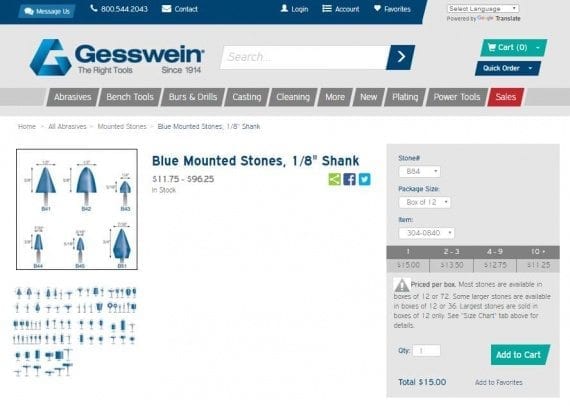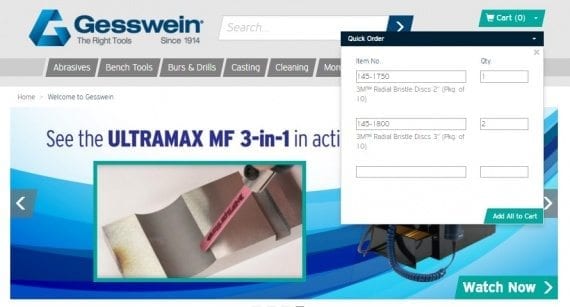
Paul H Gesswein Co. supplies precision tools and equipment to metal manufacturers. This product page at Gesswein.com allows for pricing of quantity discounts after allowing customers to make selections for stone and package size. Complex pricing is often required for B2B ecommerce sites.
An important part of redesigning or launching a business-to-business ecommerce site is to identify the required features. They can be available out of the box in your ecommerce platform, or added by a developer.
The B2B sales process is often complicated. It can be challenging to address in an ecommerce site. In this post, I’ll review 11 ecommerce features that are critical for most B2B companies.
11 Critical Features for a B2B Ecommerce Site
Complex pricing. B2B companies typically have different prices for different customers. There are multiple ways to structure this on an ecommerce site, including a discount for groups of customers, a specific price for every combination of SKU and customer, and quantity discounts for all customers or for groups of customers — or a combination of these methods.
Keeping the prices current for your thousands of customers and products can be a challenge. Plan for how you will address this. It’s typically via a system integration or via a file, to bulk upload pricing. Consider limiting certain products to specific customers or groups of customers.
Flexible checkout process. Your checkout process should match your company’s unique rules for payment and shipping. Examples include:
- Purchase orders available only to certain customers based on their credit limit and approval;
- Integration of the checkout into your customers’ buying and approval process;
- Certain products being restricted from shipping to certain states;
- Enabling customers to charge the shipping to their UPS or FedEx accounts.
Customer registration. Retail ecommerce sites often allow customers to purchase without creating an account. But for B2B sites, registration is typically mandatory. It allows customers access to the custom prices, products, and terms that they already have with you. Once customers have logged in, they can see products, prices, order-tracking information, and, potentially, even pay for offline orders.
Search. Site search is critical for retail sites and is no less crucial for B2B. Ecommerce platforms typically come with some type of search feature. But improving the quality of your site search can greatly help conversions. Sophisticated, third-party search tools can often pay for themselves quickly.
Navigation. Plan your site navigation to assist users to find the products they are looking for. This is especially important for sites with a large number of products. Common navigational tools include reductive navigation (narrowing selection by certain criteria, such as price, color, or rating), offering customers a view of their most purchased products, and recommended products based on a customer’s needs.
Mobile responsiveness. Every website today should make it easy for mobile users to interact and purchase. The easiest way to get started is to make your website mobile responsive. Consider what devices your customers will be using and which mobile features are most important to them.
Email marketing. Email marketing is a good way to drive repeat sales from your B2B customers. Integrate your ecommerce site with an email service provider — i.e., MailChimp, Bronto, ExactTarget, Silverpop, many others — to personalize and target messages based on customers’ site activity and order history.
Quick order. B2B customers often know exactly what they want, right down to the item number or SKU. Provide a form where customers can enter item numbers and quantities, to quickly add items to their cart without browsing and searching. The quick order form at Gesswein.com, a client of my firm, does this.

Gesswein.com allows customers that know the item number to quickly enter the products using the quick order tool.
Multiple users in a single account. When your customers are businesses, many people can place orders under a single account. Handling this can get complex. Will users under an account see other users’ orders? How are the users added to the account? This feature is lacking in many ecommerce platforms. It’s typically important for B2B sites.
Support for sales reps. B2B sales representatives often see the web as a threat. But an ecommerce site can be an asset to sales reps and sales reps can be assets to the site. Structure your website so it reinforces the customer’s relationship with its rep. Allow reps to log in as customers and place orders for them. Reps can use the ecommerce site to check inventory when talking to customers, to order samples of products for customers, and to access specifications and sales materials.
Request a quote. Some products are complicated to quote a price. An ecommerce site can enable customers to submit a request for a quote and to streamline the process. Speed and simplicity of doing business with your company are a competitive advantage. Use your ecommerce site to make it that much easier.
Getting Started
Each of these features can be critical for a B2B site. But they may not all be required for the first phase. Your business and sales model will determine which features are required now, versus later. Regardless, ensure that your ecommerce platform and development team can support them, whenever you choose to implement.




